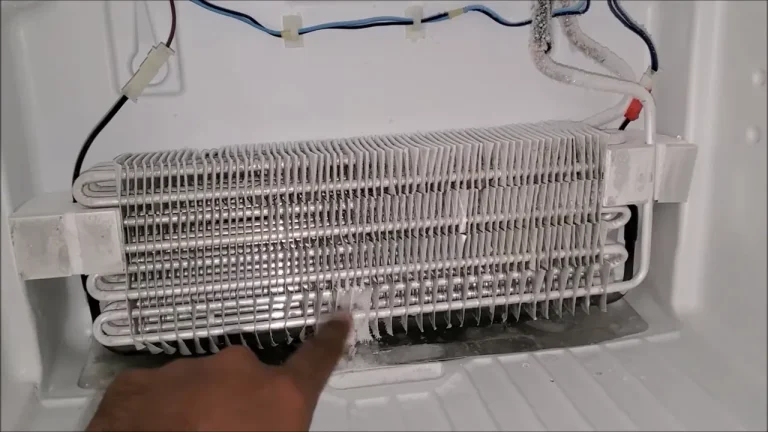GE Profile Refrigerator Ice Maker Problems French Door (Quick Fix!)
The GE Profile Refrigerator, known for its innovative features and sleek design, is a popular choice for households seeking advanced refrigeration solutions. Among its standout features, the French door configuration adds both style and functionality to the kitchen space.
Like any complex appliance, the GE Profile French Door Refrigerator with an integrated ice maker may encounter occasional issues. Whether you are dealing with ice production challenges, strange noises, or dispenser malfunctions, understanding the common problems associated with the ice maker in these refrigerators is essential.
In this article, we will delve into troubleshooting tips and solutions for GE Profile French Door Refrigerator ice maker problems, empowering you to address issues efficiently and maintain the optimal performance of this sophisticated appliance. Let’s explore the steps to diagnose and fix common ice maker-related issues in your GE Profile French Door Refrigerator.
Common GE Profile Refrigerator Ice Maker Problems French Door
1. Slow GE Profile Ice Maker
If you find that your GE Profile French Door Refrigerator’s ice maker is producing ice at a slower rate than expected, it can be inconvenient, especially during periods of high demand.
Check the Ice Maker Settings
Confirm that the ice maker is set to its maximum ice production capacity. Consult your refrigerator’s user manual to locate and adjust the settings accordingly. Some models allow you to increase the ice-making speed for more efficient performance.
Inspect the Freezer Temperature
Ensure that the freezer compartment is set to the recommended temperature, typically between 0 to 5 degrees Fahrenheit (-18 to -15 degrees Celsius). Proper freezer temperatures are essential for efficient ice production.
Verify Adequate Water Supply
Insufficient water supply can contribute to slow ice production. Check the water line for any kinks, obstructions, or low water pressure. Adequate water flow is crucial for the ice maker to function optimally.
Clean the Ice Maker Components
Over time, mineral deposits or impurities in the water can accumulate in the ice maker, affecting its performance. Clean the ice maker components, including the ice mold and water inlet valve, using a mixture of vinegar and water to remove any build-up.
Reduce Freezer Overcrowding
An overcrowded freezer can impede air circulation, affecting the ice maker’s efficiency. Organize the items in the freezer to ensure proper airflow and optimize ice production.
Consider Ambient Temperature
The ambient temperature in your kitchen can impact the ice maker’s performance. If the room is too warm, it may take longer for the ice to freeze. Ensure that the kitchen temperature is within the recommended range.
2. GE Profile Refrigerator French Door Ice Maker Runs Endless (Won’t Stop Running)
If you notice that your GE Profile French Door Refrigerator’s ice maker seems to run continuously without stopping, it can be concerning and may indicate an underlying issue.
Check the Ice Maker Shutoff Arm
Inspect the ice maker’s shutoff arm to ensure it moves freely. The shutoff arm is a wire mechanism that stops ice production when the ice bin is full. If it’s stuck or obstructed, it may fail to signal the ice maker to stop, leading to continuous operation.
Examine the Ice Bin
Look inside the ice bin for any obstructions or blockages. Sometimes, piled-up ice or other objects may prevent the shutoff arm from functioning correctly. Clear any ice buildup or debris that might be hindering the arm’s movement.
Verify Freezer Temperature
Ensure that the freezer temperature is set to the recommended level, typically between 0 to 5 degrees Fahrenheit (-18 to -15 degrees Celsius). Incorrect temperatures can affect the ice maker’s cycling and cause it to run continuously.
Inspect the Water Inlet Valve
A malfunctioning water inlet valve can lead to excessive ice production. Check for any signs of leaks or irregular water flow. If the valve is faulty, it may continuously supply water to the ice maker, causing it to run endlessly.
Reset the Ice Maker
Reset the ice maker by turning it off and then back on. Refer to your refrigerator’s user manual for specific instructions on resetting the ice maker. This simple step can sometimes resolve electronic glitches causing continuous operation.
Check for Software Updates
Some modern refrigerators with advanced features, including ice makers, receive software updates. Check the manufacturer’s website or contact customer support to see if there are any available updates for your refrigerator model.
3. GE Profile French Door Refrigerator Ice Maker Won’t Turn On
If your GE Profile French Door Refrigerator’s ice maker is not turning on, it can be a frustrating issue. Here are steps to troubleshoot and address the problem.
Check Power and Connection
Ensure that the refrigerator is properly plugged in and receiving power. Confirm that there are no issues with the electrical outlet. Additionally, check the ice maker’s connection to the refrigerator to ensure it is secure.
Verify Ice Maker On/Off Switch
Some models have a switch on the ice maker itself that controls its operation. Confirm that the ice maker is turned on. If there is a switch, toggle it to the “on” position. Refer to your refrigerator’s user manual for the location of this switch.
Inspect the Shutoff Arm
Examine the shutoff arm inside the ice maker. If it is stuck or obstructed, it may prevent the ice maker from turning on. Ensure that the shutoff arm moves freely and is not hindered by any ice or debris.
Reset the Ice Maker
Perform a reset of the ice maker. This can often be done by turning the ice maker off, waiting for a few seconds, and then turning it back on. Check the user manual for your specific refrigerator model for precise reset instructions.
Confirm Freezer Temperature
Verify that the freezer compartment is set to the recommended temperature (usually between 0 to 5 degrees Fahrenheit or -18 to -15 degrees Celsius). Incorrect temperatures can impact the ice maker’s functionality.
Inspect Water Supply
Ensure that there is an adequate water supply to the refrigerator. If the water line is kinked or blocked, it may prevent the ice maker from turning on. Clear any obstructions and check for water flow.
Check for Error Codes
Some modern refrigerators may display error codes. Check the control panel or consult the user manual for error code information. Understanding any error codes can provide insight into the specific issue with the ice maker.
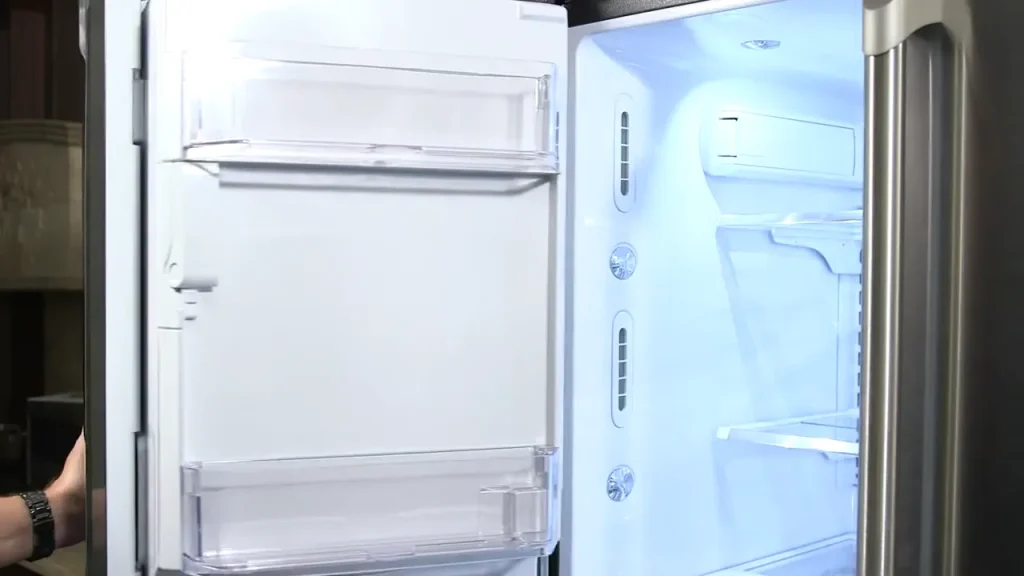
4. GE Profile Ice Maker Won’t Make Any Ice
Problem: If your GE Profile French Door Refrigerator’s ice maker is not producing any ice, there are several potential causes that you can investigate and address.
Check the Ice Maker On/Off Switch
Ensure that the ice maker is turned on. Some models have a switch located on the ice maker itself. Verify that it is in the “on” position. Refer to your refrigerator’s user manual for the specific location of this switch.
Inspect the Shutoff Arm
Examine the shutoff arm inside the ice maker. If the shutoff arm is in the raised position, it may be signaling that the ice bin is full, preventing further ice production. Lower the shutoff arm to activate the ice maker.
Verify Freezer Temperature
Confirm that the freezer compartment is set to the recommended temperature (usually between 0 to 5 degrees Fahrenheit or -18 to -15 degrees Celsius). Incorrect temperatures can hinder the ice-making process.
Clear Ice Blockages
Check for any ice blockages within the ice maker. If ice cubes are stuck or the mechanism is jammed, carefully clear the blockage. Ensure that the ice mold is free from obstructions.
Inspect Water Inlet Valve
The water inlet valve controls the water flow to the ice maker. A malfunctioning valve can hinder ice production. Check for any leaks or irregular water flow. If necessary, consider replacing the water inlet valve.
Verify Water Supply
Ensure that there is a steady water supply to the refrigerator. Check the water line for kinks or blockages. Adequate water flow is essential for the ice maker to produce ice.
Reset the Ice Maker
Perform a reset of the ice maker by turning it off and then back on. Follow the manufacturer’s instructions for resetting the ice maker, typically found in the user manual. This can sometimes resolve electronic glitches affecting ice production.
Check for Error Codes
Examine the control panel for any error codes. Modern refrigerators may display error codes that provide insight into specific issues. Refer to the user manual for information on interpreting error codes.
5. Noisy GE Profile Ice Maker
If your GE Profile French Door Refrigerator’s ice maker is generating unusual or excessive noise during its operation, addressing this issue can improve the overall tranquility of your kitchen.
Inspect Ice Maker Components
Examine the various components of the ice maker for any loose or misaligned parts. Tighten screws and bolts as needed. Ensure that ice cubes are not obstructing any moving parts, as this could contribute to increased noise.
Leveling the Refrigerator
An unlevel refrigerator can lead to increased vibrations and noise. Use a level to check the refrigerator’s alignment and adjust the leveling feet as necessary to ensure stability and proper balance.
Inspect Water Line Connections
Vibrations from the water line can contribute to noisy operation. Ensure that the water line supplying the refrigerator is correctly installed and secured. Adjustments or additional padding may be necessary to minimize vibrations.
Verify Ice Dispenser Arm Position
Check that the ice dispenser arm is properly positioned and not hitting the ice bin or any other components. A misaligned dispenser arm can lead to noise during operation.
Check for Ice Buildup
Ice buildup within the ice maker or surrounding components can lead to noisy operation. Thoroughly inspect and remove any accumulated ice or frost. Allow the ice maker to defrost and dry completely before restarting.
Evaluate Water Pressure
Inadequate water pressure can cause the water inlet valve to vibrate excessively, resulting in noise. Ensure that the water pressure is within the recommended range for your refrigerator and make adjustments if necessary.
Consider Ambient Temperature
Extreme temperatures in the kitchen or surrounding environment can impact the refrigerator’s performance and contribute to noise. Ensure the room temperature is within the manufacturer’s recommended range.
Regular Maintenance
Keep your refrigerator and ice maker well-maintained by cleaning condenser coils, checking for loose components, and ensuring proper alignment. Regular maintenance can prevent potential issues that may lead to noise.

6. GE Profile Refrigerator Ice Maker Doesn’t Work After Reset
Problem: If your GE Profile French Door Refrigerator’s ice maker fails to operate even after performing a reset, various factors could be contributing to this issue.
Proper Reset Procedure
Ensure that you followed the correct reset procedure as outlined in your refrigerator’s user manual. Different models may have specific steps, such as pressing a reset button or turning the ice maker off and on. Verify that the reset was executed accurately.
Inspect Water Supply
Check the water supply to the refrigerator, ensuring there are no kinks or blockages in the water line. A restricted water supply can impede the ice maker’s functionality. Clear any obstructions and verify that water is reaching the ice maker.
Reset the Entire Refrigerator
If a reset of the ice maker alone does not resolve the issue, try resetting the entire refrigerator. This involves unplugging the refrigerator from the power source for a few minutes and then plugging it back in. This action can sometimes address electronic glitches affecting multiple components.
Check for Error Codes
Inspect the control panel or display for any error codes. Modern refrigerators may provide error codes that offer insights into specific malfunctions. Refer to the user manual for guidance on interpreting error codes.
Inspect Water Inlet Valve
A faulty water inlet valve can hinder water flow to the ice maker. Inspect the valve for any signs of leaks or irregular operation. If necessary, consider replacing the water inlet valve to restore proper water supply.
Verify Freezer Temperature
Confirm that the freezer compartment is set to the recommended temperature range (usually 0 to 5 degrees Fahrenheit or -18 to -15 degrees Celsius). Incorrect temperatures can impact the ice maker’s performance.
Check Water Filter
An old or clogged water filter can impede water flow to the ice maker. Verify the status of the water filter and replace it if needed. Follow the manufacturer’s recommendations for the correct filter replacement.
Why is my GE French door refrigerator not making ice?
If your GE French door refrigerator is not making ice, several factors may contribute to this issue. First, check the ice maker’s on/off switch to ensure it is in the “on” position. Inspect the shutoff arm inside the ice maker to confirm it is not stuck or obstructed.
Ensure that the freezer compartment is set to the recommended temperature, typically between 0 to 5 degrees Fahrenheit (-18 to -15 degrees Celsius), as incorrect temperatures can impact the ice-making process.
Examine the water supply to the refrigerator, checking for any kinks or blockages in the water line. Adequate water flow is crucial for the ice maker to produce ice. If your refrigerator has a water filter, assess its condition and replace it if necessary, as a clogged filter can impede water flow.
If these checks do not resolve the issue, inspect the water inlet valve for leaks or irregular operation. A malfunctioning valve can hinder water supply to the ice maker.
How do I reset my GE Profile ice maker?
To reset your GE Profile ice maker, follow these general steps, but be aware that specific instructions may vary based on your refrigerator model. Locate the control panel or settings on your refrigerator; this is typically found on the inside of the fresh food compartment or on the front of the appliance.
Some models have a dedicated button for resetting the ice maker, while others may require a combination of button presses. Refer to your refrigerator’s user manual for precise instructions tailored to your specific model.
In many cases, the reset process involves holding down a specific button or combination of buttons for a set duration. Once initiated, you might observe indicator lights flashing or hear a beep, signaling that the ice maker has been successfully reset.
After completing the reset, allow some time for the ice maker to resume its normal operation and start producing ice. If you encounter difficulties or cannot find reset instructions in the manual, contacting the manufacturer’s customer support can provide additional assistance specific to your refrigerator model.
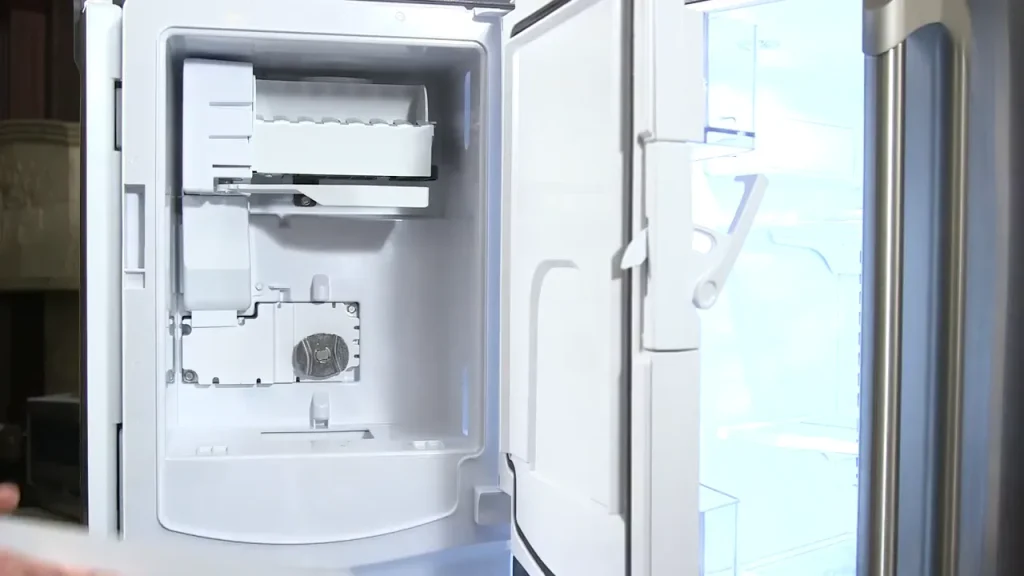
Why is my ice maker not making ice but the water works?
If your ice maker is not producing ice while the water dispenser is still functioning, several common issues may be at play. One potential cause could be a clogged or frozen water line leading to the ice maker.
Inspect the water line for any kinks, blockages, or ice buildup, and address these issues accordingly. Check the water inlet valve, which controls the flow of water to the ice maker. A malfunctioning or faulty valve could restrict water access to the ice maker while still allowing water to reach the dispenser.
Ensure the ice maker is turned on, as some models have a separate switch or lever that activates or deactivates the ice-making function. Lastly, examine the ice maker unit for any visible malfunctions, such as jammed components or a full ice bin preventing further production.
If these troubleshooting steps do not resolve the issue, it may be necessary to consult the user manual for your specific refrigerator model or seek professional assistance to diagnose and address the problem.
Why is my GE ice maker not working but water does?
If your GE ice maker is not working while the water dispenser is functioning, several factors could contribute to this issue. One common cause is a frozen water line leading to the ice maker. Check for any ice blockages or frozen sections in the water line and thaw them if necessary. Inspect the water inlet valve, which controls the water supply to the ice maker. A faulty valve may hinder water flow to the ice maker even if the water dispenser is operational.
Ensure that the ice maker is turned on; some models have a separate switch or lever that activates or deactivates the ice-making function. Confirm that the freezer temperature is set to the recommended level, as excessively low temperatures can impact the ice maker’s performance.
If the ice maker still fails to work, it’s advisable to check for any visible malfunctions within the ice maker unit, such as jammed components or a full ice bin preventing further ice production.
FAQ:
Why is my GE Profile French Door Refrigerator not making ice?
Several factors can contribute to this issue, including a malfunctioning water inlet valve, a clogged water filter, or a defective ice maker. Check the water supply, ensure the water filter is not clogged, and inspect the ice maker components for any visible issues.
How do I reset my GE Profile French Door Refrigerator’s ice maker?
Locate the control panel or settings on your refrigerator, follow the specific instructions in your user manual, and initiate the reset process. This often involves holding down a specific button or combination of buttons for a set duration.
Why is my ice maker producing discolored ice in my GE Profile French Door Refrigerator?
Discolored ice may be caused by impurities in the water supply. Replace the water filter, flush the water system, and clean the ice maker components to improve ice quality.
What should I do if my GE Profile French Door Refrigerator’s ice maker is making noise?
Noisy operation may be due to loose components, an unlevel refrigerator, or vibrations from the water line. Tighten screws, level the refrigerator, and inspect the water line for secure connections.
How can I increase the ice-making speed of my GE Profile Refrigerator’s ice maker?
Check the ice maker settings for maximum ice production, ensure proper water supply, and maintain recommended freezer temperatures. Some models may have adjustable settings for optimizing ice-making speed.
Why is my ice maker running continuously and not stopping in my GE Profile French Door Refrigerator?
This issue could be related to a stuck or obstructed shutoff arm, problems with the ice bin, or incorrect freezer temperatures. Inspect the shutoff arm, clear any ice blockages, and verify the freezer temperature settings.
What should I do if my GE Profile French Door Refrigerator’s ice maker won’t turn on?
Check the power supply, inspect the on/off switch on the ice maker, and ensure that the shutoff arm is not obstructed. Verify that the freezer temperature is set correctly and troubleshoot any electrical issues.
How do I fix my GE Profile Refrigerator’s ice maker that stopped working after a water filter replacement?
Ensure proper water filter installation, flush the water system, and check for a bypass plug if necessary. Confirm that the water line is not obstructed, and reset the ice maker according to the manufacturer’s instructions.
What can cause my GE Profile Refrigerator’s ice maker control board to malfunction?
Electrical issues, exposure to moisture, manufacturing defects, and communication failures with other components can contribute to the malfunction of the ice maker control board.
Why is my GE Profile French Door Refrigerator’s ice maker not dispensing ice?
Check for ice blockages, inspect the dispenser arm and auger, and ensure the freezer temperature is set correctly. Examine the water filter, water supply, and consider professional assistance if troubleshooting does not resolve the issue.
As an Amazon Associate I earn from qualifying purchases.
- Can You Put Clouds Shoes in the Washing Machine? With Tips & Tricks - April 10, 2024
- European Washing Machine vs American – History, Design, Technology - March 27, 2024
- Can You Put Boxing Gloves In The Washing Machine? – Expert Tips - March 25, 2024

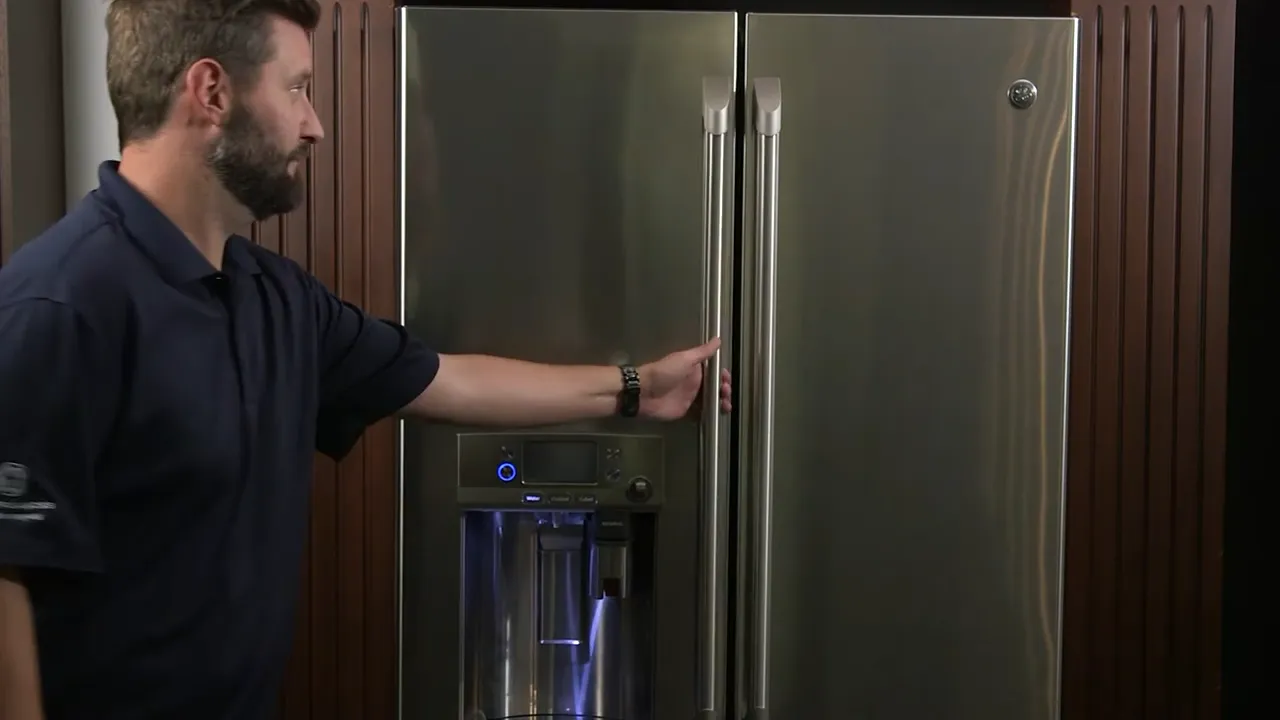
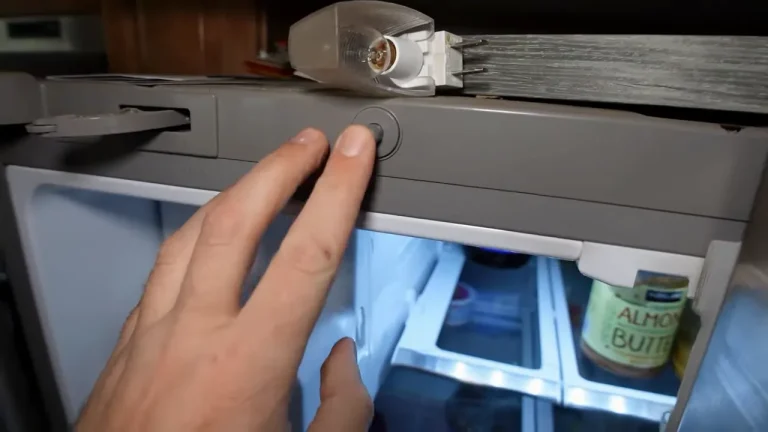
![Why Does the Samsung Refrigerator Noise Stop When Door Opened? [Solving the Mystery]](https://homeplacetips.com/wp-content/uploads/2023/10/Samsung-Refrigerator-Noise-Stops-When-Door-Open-768x461.png)
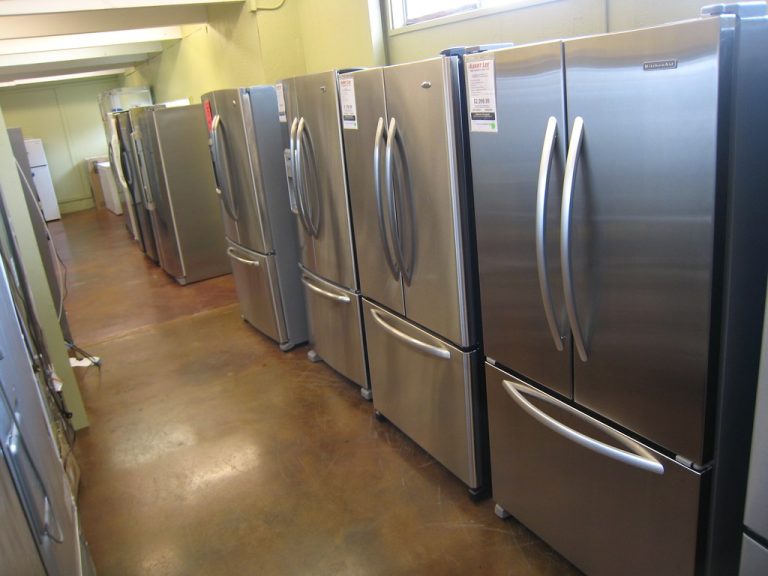
![Are GE Refrigerators Good Quality Brand? [Answer 2024]](https://homeplacetips.com/wp-content/uploads/2024/01/GE-Appliances-Bottom-Freezer-Refrigerator-with-33-Width_000004966-768x432.webp)

